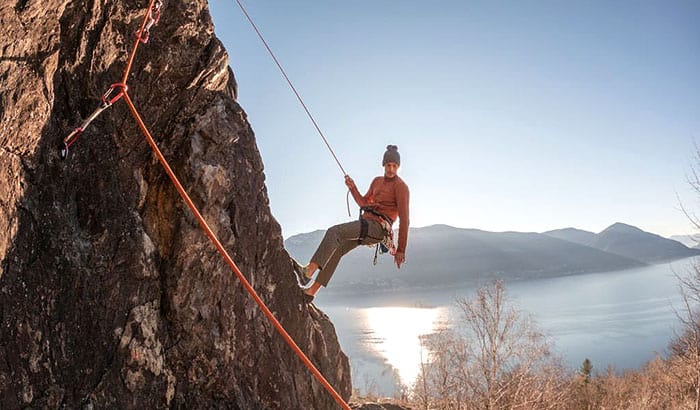One of the most difficult and dangerous types of rock climbing is doing free solo climbing. Climbers doing this type of climb do not use ropes, harnesses, and other protective equipment during the climb. They rely only on their strength, skills, and preparation to go to the top. But, how do free solo climbers get down? Let us find out below how free solo climbers get down after the climb.
Contents
Method No. 1: Walking Off
Walking off is the easiest way that a free solo climber does when he wants to go down. Once the climber reaches the top, he can easily walk down on the more accessible side of the mountain, provided that there is an easier way of going down.
Once a free solo climber is climbing a more challenging or longer climb, that route usually has a way of walking down via walk-off. There is usually a way to walk down in a less steep part of a particular rock formation if someone is doing free solo rock climbing.
Most of the free solo climbers are usually engaged on shorter routes or those hardest routes on the cliff so that they can have an easier way when going down. In fact, many of the routes being chosen by free solo climbers always have an easier way of going down.
There is no better way to enjoy free solo climbing than reaching the top and enjoying the view. But when going down, having to follow up your climb with a lush walk off while witnessing the sunset is totally a one-of-a-kind experience to remember.
Method No. 2: Down Climbing the Route
When a free solo climber is dealing with an easier climb in a single pitch, downclimbing the route is an excellent option. Down climbing is all about climbing down the cliff using the same way they climb to the top or using a different way but is something more manageable.
Down climbing is very uncommon on technical down climbing routes because it can get very dangerous to the climber. Imagine having to go down without seeing the footholds, and having no protection can be a life-threatening situation.
However, people who do many down climbs are expected to be very well-trained and experienced. In fact, climbers who do a lot of free soloing are usually outstanding down climbers as well.
If you try to analyze it, it should be because down climbing skills are needed when going down. Some routes provide down-climbing as the only option when going down. So, it is a must for them to be very good at it.
Method No. 3: Rappelling
Another way that a free solo climber can get down after the climb is to rappel back down to the ground. This method can be inconvenient to a free solo climber since it will need him to bring a rope for the simple reason that it will be required during the descent through rappelling.
In rappelling, the climber uses a belay device which will create friction to allow the climber to manually let the rope go through so that it can be lowered slowly and safely. However, when you are alone, it can be very difficult. If you have a support crew, then they will have the ropes to rappel.
Also, free solo climbers usually use this method if the rock is clean and is suitable for rappel anchors. However, there are things that you need to consider when considering this method. First, you need to make sure that the rope will reach the ground or a stance that will be used to set up the rappel.
Then, you also need to consider if you can retrieve the protection hardware being set up and the rope without snagging it during the rappelling. All of these concerns make this method fun but dangerous. There is just a little room for errors and many areas where you can make mistakes.
Method No. 4: Base Jumping
As a sport, base jumping is when someone jumps from fixed objects using a parachute for him to descend safely on the ground. When it comes to free solo climbers, many climbers have transitioned from being regular free solo climbers to full-pledge base jumpers.
Base jumping is another recreational sport, and combining it with free solo climbing can be a unique but fun experience. But the risk of having an accident or getting injured is too high that it will be better for you to train professionals or take a course in base jumping. Doing this step will make you knowledgeable and learn what is needed after you jump.
Taking a BASE course also means that you need to be familiar with skydiving as it is a necessity if you want to learn base jumping. Skydiving will also teach you how to position your body correctly and learn how to fly, steer, and land a canopy.
The challenge of using base jumping as a way to go down is the setup. You will need to bring a lot of things during the climb, which can affect the quality of your climb. But nevertheless, this method is an interesting way to go down after a free solo climb. And mind you, more and more free-soloists are doing it today.
Conclusion
How do free solo climbers get down? There are different ways to do it. From a very simple walkout to the more complicated base jumping, free solo climbers will have so many options to make it safely to the ground. The most important thing is to be safe during the climb and go back safely to the ground using any method stated above.

